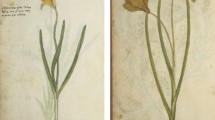Summary
Considering that the cineraria originated comparatively recently, and under what must be regarded as the best of horticultural conditions, it is rather surprising to realize the paucity of factual historical evidence relevant to the origin and development of the complex. The summarized facts are as follows: The progenitors of the cineraria belong to the sectionPericallis of the genusSenecio, a group restricted to the Canary Islands, the Azores, and Madeira. This group was introduced into cultivation in 1777 and 1780. By the early 1800’s the cineraria was distinct from its progenitors; by the late 1800’s, it encompassed numerous cultivars and great diversity of form. The biological origin of the complex has been studied fitfully, but the available evidence suggests that the cineraria is of hybrid, origin, involvingSenecio cruentus andS. heritieri and possibly several other species.
The cineraria is worth reviewing because it is a highly developed complex of cultivars the possible ancestry of which is a limited group of readily measurable insular endemics. Therefore, the cineraria should be a convenient vehicle for studying evolution under the hand of man.
Similar content being viewed by others
Literature Cited
Aiton, W. 1789. Hortus Kewenis,3:219–222. London. (Pritzel 78).
Alter, N. 1939. Data and notes onCineraria. Ohio Agr. Expt. Sta.: Bimonthly Bull.24: 95–99.
Bailey, L. H. 1914–1917. The standard cyclopedia of horticulture. 6 vols. Macmillan Co., New York.
Bateson, W. 1895. (letters to the editor). Nature51: 605–607;52: 29, 103-104.
— 1897. Notes on hybrid cinerarias produced by Mr. Lynch and Miss Pertz. Proc. Cambridge Phil. Soc.9: 308–309.
Bonstedt, C. 1927. Allendorffs Kulturpraxis der Kalt-und Warm-hauspflanzen. Paul Parey, Berlin.
Botting Hemsley, W. 1895. (letter to the editor). Nature52: 54–55.
Booth, C. O. 1957. An encyclopaedia of annual and biennial garden plants. Faber & Faber, London.
Bornemueller, J. 1904. Ergebnisse Zweier botanischen Reisen nach Madeira und die Canarische Inseln. Englers Bot. Jahrb.33: 387–402.
Bouche, P. C. 1824. Ueber einige Abarten von Cinerarien. Verhandlungen des Vereins zur Beförderung des Gartenbaues in dem Königlich Preussischen Staaten.1: 139.
Burbidge, F. W. 1877. Cultivated plants, their propagation and improvement. William Blackwood & Sons, Edinburgh and London.
Chittenden, F. J. (ed.) 1956. Royal Horticulture Society dictionary of gardening. 4 vols. Oxford.
Christ, H. 1885. Vegetation und Flora der Kanarischen Inseln. Englers Bot. Jahrb.6: 458–526.
— 1888. Spicilegium canariense. Englers Bot. Jahrb.9: 86–172.
Curtis’ Botanical Magazine (London). 1788, 1798.2:pl. 53;12:pl. 406. (Pritzel 2007).
Darwin, C. 1877. The effects of cross and self fertilization in the vegetable kingdom. D. Appleton & Co. Now York.
DeCandolle, A. P. 1837.Senecio in Prodromus systematis naturalis regni vegetabilis...6: 340–437. Treuttel & Würtz. Paris. (Pritzel 1485).
Drummond, J. 1826. (Article on cineraria). Gardener’s Magazine2: 153–154. Original not seen by me; reprinted in cditorial in Gardeners’ Chronicle III.17: 742. 1895.
Flores des Serres et Jardins de L’Europe (Gand). 1877.22: 173–174.
Focke, W. O. 1881. Die Pflanzen-mischlinge. Gebrüder Borntraeger, Berlin.
Gardeners’ Chronicle (London). 1895. (editorials) Series III,17: 588, 655, 742.18: 89–90.
Gilmour, J. S. L., C. J. King, and L. H. J. Williams. 1963. The plants ofSertum Anglicum. In G. H. M. Lawrence (ed.), Hunt Facsimile Series, No. 1; C.-L. L’Heritier de Brutelle,Sertum Anglicum. Hunt Botanical Library. Pittsburgh.
Hoffman, O. 1889.Compositae in Engler & Prantl, Die natürlichen Pflanzenfamilien.4(5): 87–387.
Journal d’horticulture, 1845.2: 231. (Not seen by me; quoted by Bateson in Nature51: 605–607. 1895.)
Lems, K. 1956. Flora Fortunatarum, a floristic list of the Canary Islands. Oberlin. (mimeographed list).
— 1960. Floristie botany of the Canary Islands. Sarracenia5: 1–94. (publ. by Institut Botanique de l’Université de Montreal).
L’Héritier de Brutelle, Charles-Louis. 1788.Sertum Anglicum. Paris. Reprinted 1963 as No. 1 of the Hunt Facsimile Series, G. H. M. Lawrence, ed., by the Hunt Botanical Library, Pittsburgh. (Pritzel 5270).
L’Illustration Horticole (Gand). 1885.32: 75, t. 556.
Lowe, R. T. 1858. A manual flora of Madeira and the adjacent islands of Porto Santo and the Desertas. Vol. 1, Dichlamydeae. John Van Voorst. London. (Pritzel 5647).
Lynch, R. Irwin. 1897. (letter to the editor). Nature55: 341.
— 1901. Hybrid cinerarias. J. Royal Hort. Soc.24: 269–274.
Masferrer y Arquimbau, D. R. 1881. Recuerdos Botanicos de Tenerife. Anales de la Soc. Española de Historia Natural.10: 132–230.
Musehler, R. 1909. Systematische und pflanzengeographische Gleiderung der afrikanischen Senecio-arten. Englers Bot. Jahrb.43:1–74.
Philip-Smith, Edith. 1933. The calibration of flower color indicators. Protoplasma18 (1): 112–125.
Pitard, J., et J. Proust, 1908. Les Iles Canaries, Flore de l’Archipel. Klincksieck. Paris.
Robinson, G. M., and R. Robinson. 1931. A survey of anthocyanins. Biochem. Jour.25: 1687–1705.
Rolfe, R. A. The Cineraria. Gardeners’ Chronicle III.3: 654.
Senianinova-Korchagina, M. 1951. On some regularities of teratological phenomena inCineraria hybrida Willd. [in Russian] Moskv. Obshch. Isp. Prirody. Bui. Otd. Biol.56(6): 47–62.
Thiselton-Dyer, W. T. 1895. (letter to the editor). Gardeners’ Chronicle III.18: 186.
— 1895. (letters to the editor). Nature51: 459–461;52: 3-4, 78-79, 128-129.
Webb, P. B., et S. Berthelot. 1836–1850. Histoire naturelle des Iles Canaries. III Phytographia canariensis. Sects. I, II, III. Paris. (Pritzel 10023).
Weldon, W. F. R. 1895. (letters to the editor). Nature52: 54, 104, 129.
Willdenow, K. L. 1809. Enumeratis plantarum horti regii botanici Berolinensis. Berolini. (Pritzel 10285).
Author information
Authors and Affiliations
Additional information
Contribution No. 678, Department of Botany and Plant Pathology, Kansas Agr. Expt. Station, Manhattan. Botany Serial No. 841. Research supported in part by the Kansas State University Bureau of General Research.
Rights and permissions
About this article
Cite this article
Barkley, T.M. A review of the origin and development of the florists’ cineraria,Senecio cruentus . Econ Bot 20, 386–395 (1966). https://doi.org/10.1007/BF02904060
Received:
Issue Date:
DOI: https://doi.org/10.1007/BF02904060




